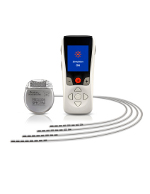Salim Hayek, MD, program director, Anaesthesiology Pain Medicine at the University Hospitals Case Medical Center, discusses personalizing spine patient care.
Question: What technological advancements have made it possible to deliver more personal spine pain care?
Dr. Salim Hayek: In medical management in general, treatment is always tailored independently and specifically for a patient. But if someone takes a medication, it travels through the bloodstream and affects multiple organ systems. Such treatment is not specific.
 Technological advancements have allowed for precise targeting in the spine or brain (such as with the Precision Spectra system), or the destruction of particular nerves with radiofrequency lesioning, or stimulate or modulate nerves through electronic currents such as with spinal cord stimulation.
Technological advancements have allowed for precise targeting in the spine or brain (such as with the Precision Spectra system), or the destruction of particular nerves with radiofrequency lesioning, or stimulate or modulate nerves through electronic currents such as with spinal cord stimulation.
Q: How is the philosophy for treating chronic back pain patients changing?
SH: There is more focus on earlier intervention and interdisciplinary care. People who have acute back pain tend to relapse and have chronic back complaints. If a patient is not back to work after six months, the likelihood they'll return at all is slim. The focus has been on rehabilitation and on aggressive treatment to control pain early on.
Q: What challenges still lie ahead for physicians treating chronic back pain patients?
SH: It is really difficult to identify which patient will have a back pain episode and relapse and go into chronic pain. Other challenges include the human psyche. Multiple elements contribute to pain on top of the physiological factors, such as the psychological, emotional and social factors. It is also a challenge to identify patients who need an integrated approach to prevent loss of work and functional productivity.
Q: How can the Precision Spectra Spinal Cord Stimulator System improve patient care?
SH: The Precision Spectra System is a highly advanced system that allows broader treatment of back and lower extremity pain. It also offers improved flexibility for the surgeon because it offers advanced controls, so that one is not stimulating areas that are not manifesting pain. Essentially, it offers excellent precision targeting and delivery of personalized pain care to patients.
Q: What does it take for physicians to incorporate the Precision technology into their practice?
SH: Interestingly, a number of healthcare providers and patients are still not aware of neurostimulation and its beneficial effects on back/limb and neuropathic pain. The first step starts with education — for the PCP and for the specialist. Physicians would need to be trained to identify the best patient candidates. They would also need to be trained on how to provide a psychological evaluation prior to treatment and applying the therapy to those patients. Physicians need to better understand neurostimulation.
Q: Where do you see the biggest opportunities for growth for treating back pain patients in the future?
SH: Treatment for chronic pain patients is a big financial burden on the healthcare system. Neurostimulation offers an effective option for managing patients with back and leg pain. Applications like the Precision Spectra System are showing evidence that they can make a difference in patients whose back pain may not be well controlled. Another opportunity involves emerging indications, such as stimulation of the peripheral nerve and end receptors as well as novel applications, such as dorsal root ganglion stimulation.
More Articles on Spine Physicians:
Spine Surgeon Relationships With Device Companies: Where They Could Go Wrong
Are Outcomes for Cervical Spinal Fusion Different With BMP: 5 Findings
2014 Spine Field Observations: What the Future Demands of Spine Surgeons

